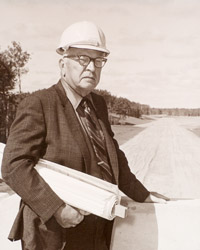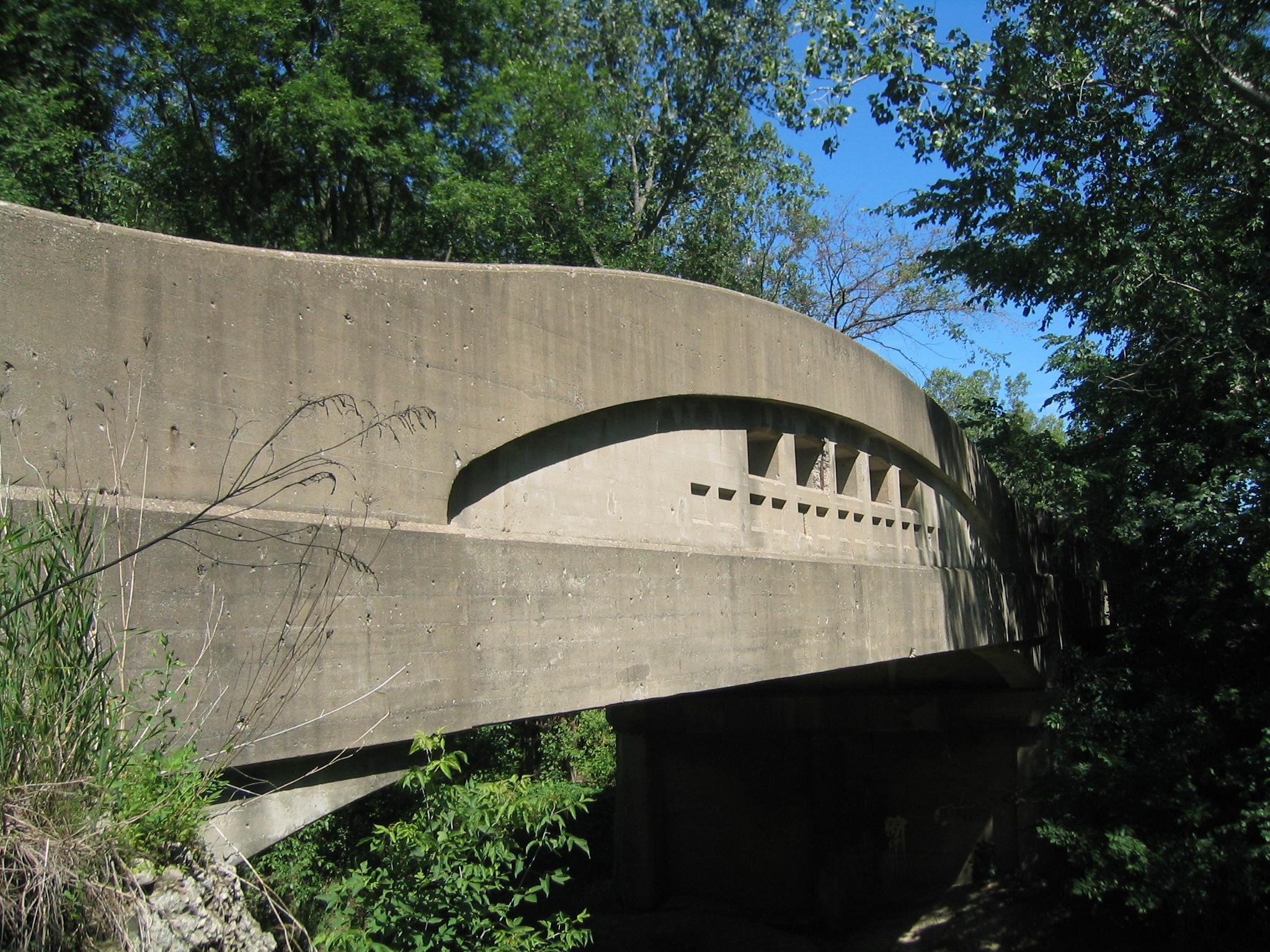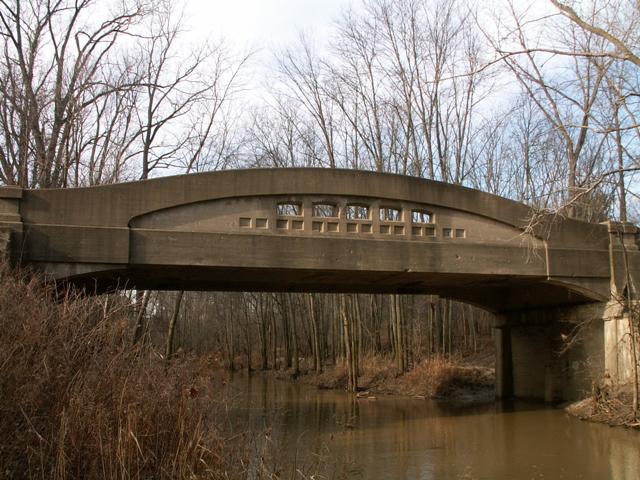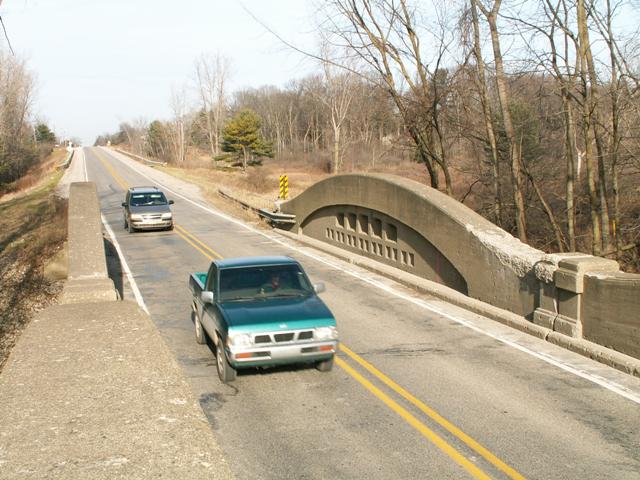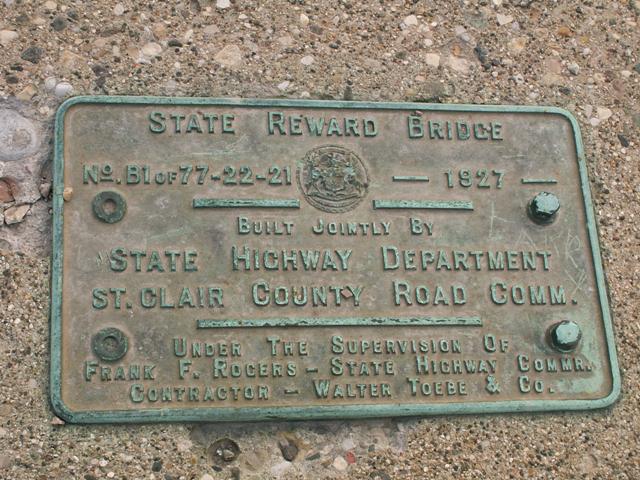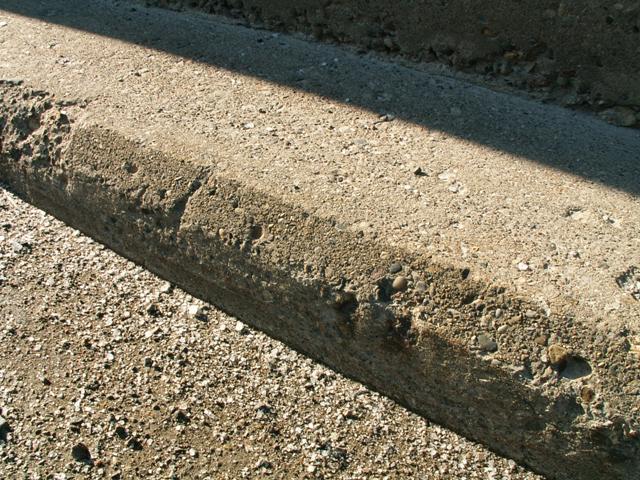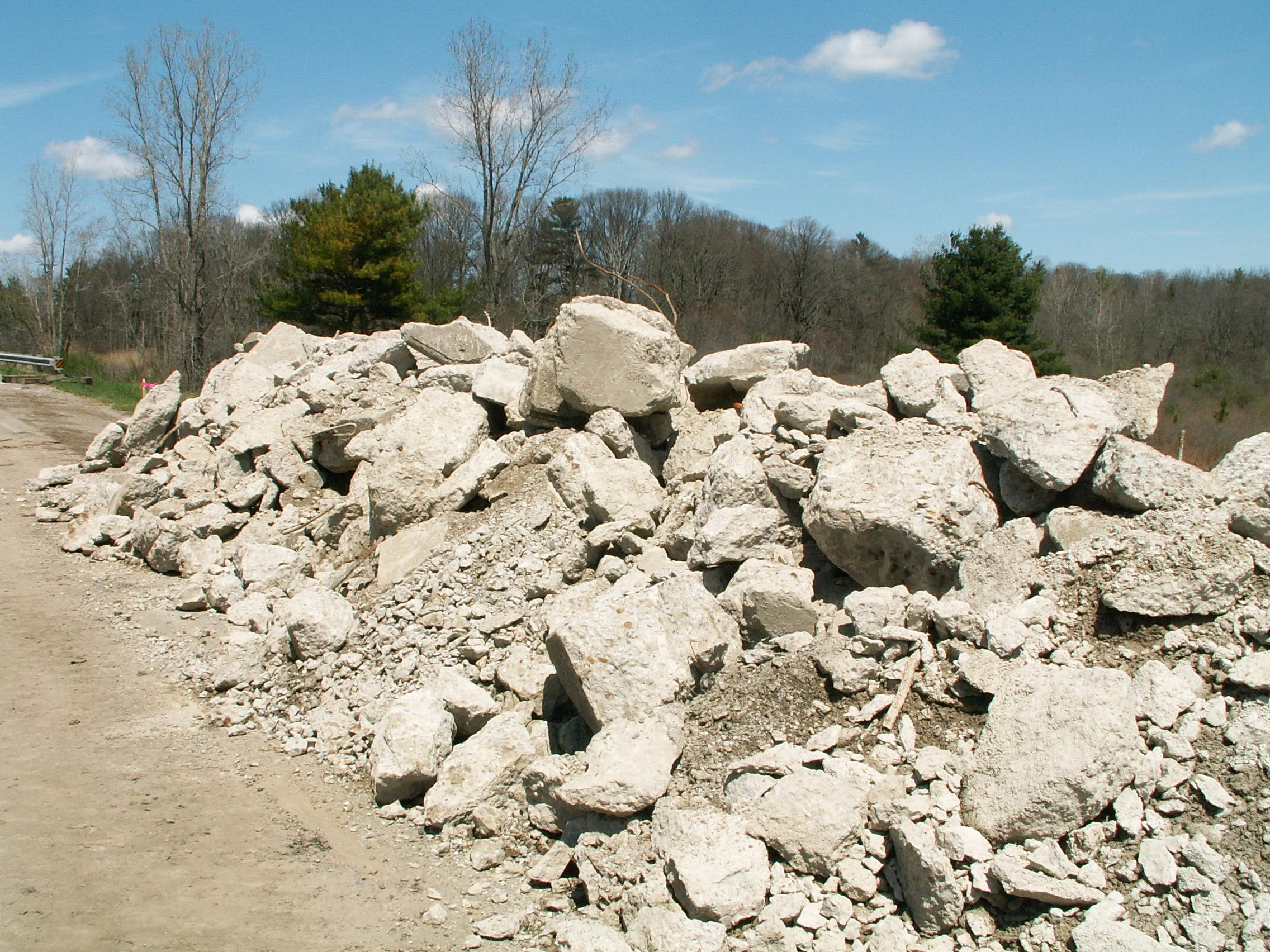We Recommend:
Bach Steel - Experts at historic truss bridge restoration.
BridgeHunter.com Phase 1 is released to the public! - Visit Now
Wadhams Road Bridge
Mitchel Road Bridge
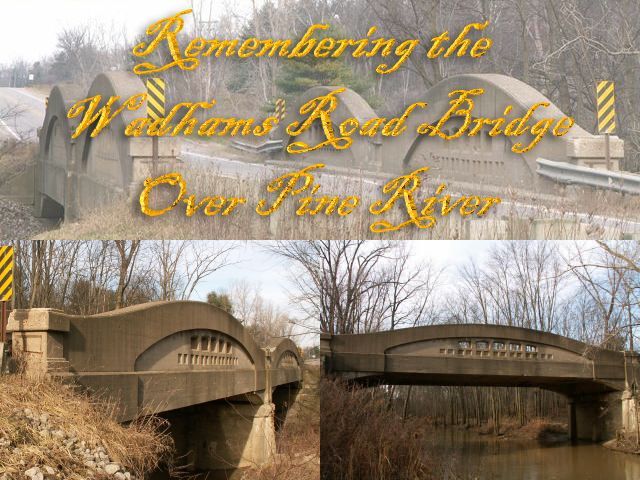
Primary Photographer(s): Nathan Holth
Bridge Documented: July 23, 2003 - 2007
Rural: St. Clair County, Michigan: United States
1927 By Builder/Contractor: Walter Toebe Company and Engineer/Design: Michigan State Highway Department
Not Available or Not Applicable
75.0 Feet (22.9 Meters)
150.0 Feet (45.7 Meters)
22 Feet (6.71 Meters)
2 Main Span(s)
77200066000B020

View Information About HSR Ratings
Bridge Documentation
This bridge no longer exists!
This bridge's song is:
Additional Information: Wadhams Road was apparantly known as Mitchel Road when this bridge was built, based off newspaper articles.
This historic bridge was demolished on April 24, 2007.
View The Original Plans For This Historic Bridge
Learn about Michigan's Unique Concrete Camelback Bridges
From everything that man erects and builds in his urge for living, nothing is in my eyes better and more valuable than bridges. They are more important than houses, more sacred than shrines. Belonging to everyone and being equal to everyone, useful, always built with a sense, on the spot where most human needs are crossing, they are more durable than other buildings and they do not serve for anything secret or bad.
Quotation from The Bridge on the Drina by Ivo Andric, 1945
Overview and Significance

A structure does not have to be famous to be historic. Thousands of people cross this bridge daily, yet few likely realize that this is one of Michigan's most important historic bridges. During the early 20th Century, Michigan became a leader in developing standard plans for bridges. Among those plans, Michigan developed a structure type that was functional, attractive, and extremely durable. Technically described as concrete curved top chord through girder bridges, these are commonly called concrete camelback bridges. Only Michigan and occasionally neighboring Ontario built this unique design. The curve of the girder creates a graceful, arch-like appearance to these structures, giving them a great deal of aesthetic value. Additional architectural elements such as pierced openings and patterns of squares compliment the design. MSHD designed plans for this structure type in a number of different lengths. The appearance of these bridges varies between these lengths. For example, a concrete camelback bridge with a span of 60 feet features a shallow curve and no pierced openings in the girders. A 90-foot structure in contrast, features tall girders, with strongly defined curves and additional architecture in the form of pierced openings in the girders.
Concrete camelback bridge construction occurred primarily in the 1920s. The physics of the bridge design limited roadway width, and as demands for wider bridges increased, more flexible structure types such as the steel stringer became the preferred structure type. The concrete camelback bridge used relatively generous amounts of reinforcing rods and concrete in its design, resulting in a very strong and durable structure. Only the narrow deck width, which is usually only 20 feet, is a setback to the structure type. This setback has proven more of a concern in today's era of truck traffic and a lack of concern for speed limits and safe driving.
Today, aside from the Mottville Bridge, there are only two multi-span concrete camelback bridges remaining, and both are two-span structures composed of approximately 70 foot spans. Both bridges are having their fate decided. One is the state-owned M-32 Spur Bridge in Montmorency County. MDOT is studying different alternatives for the structure, some including preservation and others including demolition. The fate of this bridge, which is currently in fair physical condition, is unknown. The other structure is the Wadhams Road which is owned by the St. Clair County Road Commission, and is scheduled for demolition in 2007. This bridge is actually in amazingly excellent condition, and is not even considered structurally deficient. However, the road it is on is busy, and it is considered to be too narrow to safely carry the trucks that use this road. The solution here seems simple, which is to construct a one-lane bridge next to the historic structure and form a one-way couplet, and then rehabilitate the historic structure. However, a lack of concern from the St. Clair County Road Commission, government policy that encourages wasteful demolition and replacement while also discouraging proper bridge maintenance to prolong structure life, has resulted in the fate of this bridge being demolition.
2004 National Bridge Inventory Structural EvaluationWadhams Road Bridge Over Pine RiverDeck Condition: Fair Condition Superstructure Condition: Good Condition Substructure Condition: Satisfactory Condition Scour: Foundations determined to be stable for calculated scour conditions Bridge Railing: Meets currently acceptable standards. Structural Evaluation: Somewhat better than minimum adequacy to tolerate being left in place as is Water Adequacy Evaluation: Equal to present minimum criteria Note: Conditions can range from Failed, Imminent Failure, Critical, Serious, Poor, Fair, Satisfactory, Good, Very Good, and Excellent. Source: www.nationalbridges.com |
Historic Overview and Review of Significance

The Wadhams Road Bridge is a two-span structure composed of 70 foot spans. The bridge was built in 1927 by Walter Toebe and Company, a prolific and important 20th Century Michigan contractor. The structure replaced a metal pin-connected Pratt through truss bridge. This preceding structure is described in the plans for the concrete bridge as a 110 foot Pratt truss with a 16 foot roadway, a wooden deck, supported by caissons. The truss bridge had an extensive approach system of seven spans with a total length of 125 feet, these being supported by I-beam bents. Among the plans for the bridge were details for a temporary structure to aid in keeping the road open to traffic, while the concrete girder bridge was being built. This suggests that the crossing has historically been an important local crossing, something that has remained true to the current day, thanks to a nearby I-94 entrance/exit. As a 1927 structure, the Wadhams Road Bridge is a late example of its type, late being a relative term for this short-lived bridge type that was only built in the 1920s. However, perhaps because of this, the structure has remained in excellent structural condition. Despite being a later example, its multi-span design coupled with excellent historic and structural integrity combine to make this one of Michigan's most significant bridge types. Because this bridge type was only built in Michigan, this bridge could be considered a nationally significant structure.
Given the rarity of this structure as a multi-span example, both on a local scale and a national scale, as well as the remarkable physical condition, this bridge earns an extremely high HSR.

Politics of Historic Bridges: The Bureaucracy

The road commission has refused to select any alternative that retains the historic structure, including a one-way couplet option, citing the increased costs with doing so. Current government historic bridge policies are weak and do not place any pressure on St. Clair County to preserve the bridge. Replacement is the standard, and a strong argument has to be present for preservation. This is inefficient, and instead transportation agencies should instead be forced to seriously consider preservation first and consider demolition only under extreme circumstances. This process would help ensure that taxpayer money was not being wasted when structures that could be rehabilitated on low-traffic-volume roads for less than the cost of replacement. It would also help ensure that bridges of extraordinary significance, like the Wadhams Road Bridge, would be restored at any reasonable additional cost. Instead, like many states, standards and policies for bridges in Michigan inhibit bridge preservation and encourage demolition and replacement. MDOT’s recently initiated Local Bridge Program, which provides bridge funds to county road commissions, does not use federal funds and as such, Section 106 protection for historic properties is not required when a county uses this money to demolish a historic bridge. The previous program, the Critical Bridge Program, was no better; although it required Section 106 for historic bridges, it would not fund repair projects, which encouraged counties to let structures deteriorate and then replace, rather than engaging in proper maintenance. Wadhams Road Bridge will be demolished under the Local Bridge Program, and as such, the county is not required to mitigate the adverse effect of demolishing the bridge, let alone preserve the bridge. Another problem is that despite some exceptions, county road officials generally do not seem to care about history and beauty on their roads. Most mission statements on road agency websites mention efficiency and safety, but beauty, desirability, and historic preservation are not seen. Perhaps they should be. Finally, Michigan's State Historic Preservation Office has not worked to save the bridge either. While the SHPO's power is limited, if it were to more actively work for historic bridges it is possible that more bridges might be saved, and public awareness might also be increased.
Feasibility of Preservation

Tom Byle, assistant engineer for the Kent County Road Commission once did work to try to save a structure that was nearly identical to the Wadhams Road Bridge that was up for replacement, the Thornapple River Drive Bridge over Thornapple River. His plan was to offer the bridge to the township to be used as a pedestrian crossing next to the replacement. He knew that he could use hydraulic jacks to slide the bridge over so it would have been out of the way of its replacement, ready to serve pedestrians, an operation that would cost less than demolishing the bridge. However, due to an unwilling township, and also multi-million dollars homes that refused to sell off a sliver of land for this use, the plan never unfolded and the bridge was demolished, making the Wadhams Road Bridge that much more rare. It might seem like moving a bridge as large and heavy as the Wadhams Road Bridge would be impossible. This example however, raises the point of how easy it would be to move the bridge aside for use as a pedestrian crossing and historic exhibit. Also, the Thornapple River Drive bridge was in slightly worse condition than the Wadhams Road Bridge, but it was Tom Byle's opinion that once moved aside, safe from road salt and heavy traffic, the bridge would have lasted indefinitely. Imagine how long the Wadhams Road Bridge, in pristine condition could have remained a useful structure for pedestrians! Thus, it was without a doubt possible, and even quite feasible, to preserve the historic Wadhams Road Bridge, while also creating a wider structure to carry the vehicular traffic. The only reason it did not happen was because the road commission did not want to do the paperwork nor fork over the additional money it would have taken to preserve this priceless historic artifact.
Don't Care About History and Beauty? Why You Should Still Care About Historic Bridge Demolitions

Even people who are not historians should frown at the way government transportation agencies spend tax payer dollars, because in many cases they are wasting it. Imagine that you are have a low-income, and have to spend your money very carefully. However, every year for Christmas, your rich relative sends you a gift certificate of $50,000 to be used at a car dealership to buy a new car. The gift certificate money cannot be used to repair your existing car; it can only be used to buy a new car. Would you bother with spending the money to do proper maintenance on your car during the year, such as changing the oil or keeping the tires in good working order? Perhaps not, since you know you will be getting a new car next year, and you don't want to waste the little money you have maintaining a car you are just going to get rid of at the end of the year anyway. Sound wasteful? It certainly is, and this is how the government spends your money on roads and bridges. If this bothers you, consider contacting your U.S. Representatives and Senators and letting them know that this needs to change.
However, if you perhaps do not care about how the government spends your money either, there is still another reason to protest these historic bridge demolitions, and that is construction. Many people hate having to take a detour for six months around a construction site on a road they use daily to get to the expressway. For motorists, construction work is misery; orange signs are a dreaded sight on a road. Bridge replacement often means much worse than simply reduced speed limits and a one-lane road with a flagman, which may be annoying enough. Bridge replacement often means total road closure, and a long detour around the construction for many months while work is completed. In contrast, bridge restoration projects, and certainly routine repair projects, mean you have less delays on the road, because these types of repair projects can be completed faster, and may not cause the road to be closed.
Conclusions

Because of its rarity as a two-span structure, as well as its remarkable physical condition, Wadhams Road Bridge is today one of Michigan’s most important historic bridges. From a bridge enthusiast’s perspective, this is a bridge important enough to Michigan’s transportation heritage that it should be preserved even if the cost to do so would be greater than replacing the bridge. The remarkable condition of the bridge suggests not only the historic integrity of the structure, but the lower cost of rehabilitation compared with other more deteriorated bridges. St. Clair County is essentially demolishing a bridge that is three quarters of a century old and is not even in poor condition.
The demolition of the Wadhams Road Bridge will mark one of the greatest historic bridge atrocities documented on this website since its creation in 2003, alongside such bridges as the Shanley Road Bridge, the Blue Rock Road Bridge, and the Hickory Bridge. The demolition of the Wadhams Road Bridge will be one of the most wasteful bridge demolitions ever done, considering the good structural condition of the bridge. The demolition of the Wadhams Road Bridge will rob St. Clair County and all of Michigan of a nationally significant historic structure with graceful beauty and unrivaled structural and historic integrity. Above all, the demolition of the Wadhams Road Bridge marks a failure of the government to spend money efficiently, maintain the beauty and desirability of the region, and preserve a rare piece of heritage that has served faithfully for three quarters of a century. Any additional cost to restore this bridge as a one-way couplet would have been money well spent, when the long-term benefits are considered.
This website covers much of the United States and Canada, but at the heart of its coverage is Michigan, as the name suggests. At the time of this bridge's doom, this website has grown in size and fame, but has not reached the level that would allow it to sway government or public to save this bridge, unfortunately. As a result, an enormous photo gallery present on this page attempts to both document and also form a memorial to one of the most important, and beautiful, historic bridges remaining in Michigan in the 21st Century. In addition, detailed scans of the original plans are available for the structure, a rare bonus to documenting a historic bridge, courtesy of the St. Clair County Road Commission. These photos and plans cannot possibly hope to take the place of the bridge itself, but might serve as a reminder of a bridge that would otherwise fade into the fog of the past.
Projects like Turning The Tide, and any efforts from other historic bridge enthusiasts have come too late to save the greatest historic bridges that have fallen since the turn of the 21st Century. Still, the pursuit of such programs continues to be a worthy cause. Anyone who is interesting in historic bridges and can help out with such a cause, please consider doing so. There are many other remaining historic bridges that deserve preservation that will meet the same fate as the Wadhams Road Bridge if this country's policies remain unchanged. Even when the some of the greatest bridges have already fallen, the war for historic bridge preservation must go on!
Information and Findings From MDOTThe Wadhams Road Bridge merits National
Register designation as one of the few surviving multiple-span
structures of its type, the state's unique curved-chord through girder.
The Michigan State Highway Department developed its standard for the
curved-chord through girder in the 1921-1922 biennium, and in 1922 built
the first structure of this design, a 90-foot span over the Raisin River
at Tecumseh. Concrete through-girder bridges fell from favor by the end
of that decade because they could not be widened to accommodate
increasing traffic volumes and loads.
|
Walter A. Toebe Information From MDOT
Walter A. Toebe (1897-1985) |
This bridge is tagged with the following special condition(s): Unorganized Photos
![]()
Photo Galleries and Videos: Wadhams Road Bridge
Through The Seasons
Original / Full Size PhotosA collection of Wadhams Road Bridge photos from the spring and summer months that have artistic value. Photos in this gallery are sorted by when they were taken, showing the bridge in different seasons and days. Due to the growth around this bridge however, the majority of photos are from winter. This gallery offers photos in the highest available resolution and file size in a touch-friendly popup viewer.
Alternatively, Browse Without Using Viewer
![]()
Winter 2006/2007 Visit
Original / Full Size PhotosA collection of Wadhams Road Bridge photos from two nearly identical winter days. During these visits which both occurred within a couple weeks of each other around New Years 2007, weather conditions permitted a variety of good angles. Photos are sorted by the location they were taken, to accurately record the appearance of the bridge. This gallery offers photos in the highest available resolution and file size in a touch-friendly popup viewer.
Alternatively, Browse Without Using Viewer
![]()
Overview and Elevation
Mobile Optimized PhotosThese photos both provide both artistic value, as well as a documentation of the bridge's appearance and design. Photos are sorted by the location they were taken, to accurately record the appearance of the bridge. This gallery features data-friendly, fast-loading photos in a touch-friendly popup viewer.
Alternatively, Browse Without Using Viewer
![]()
Portal, Roadside, and Traffic
Mobile Optimized PhotosPortal and roadside girder views provide both artistic value and a documentation of the bridge. Traffic views showing heavy traffic might seem to support the road commission's decisions, but to preservationists instead offer a look at the strength of a structure that has stood for nearly 75 years. This gallery features data-friendly, fast-loading photos in a touch-friendly popup viewer.
Alternatively, Browse Without Using Viewer
![]()
Details and Deck
Mobile Optimized PhotosThese photos are mainly to document the construction and physical condition of the bridge's superstructure and substructure components. This gallery features data-friendly, fast-loading photos in a touch-friendly popup viewer.
Alternatively, Browse Without Using Viewer
![]()
Close-Up Details
Mobile Optimized PhotosThese photos are mainly to document the construction and physical condition of the bridge's superstructure and substructure components. The photos here focus on very small sections of the bridge, showcasing the lack of spalling, and the attention to design detail in this bridge type. This gallery features data-friendly, fast-loading photos in a touch-friendly popup viewer.
Alternatively, Browse Without Using Viewer
![]()
Demolition and Replacement
These photos document what St. Clair County Road Commission did with one of Michigan's most important and nationally significant bridges. This photo gallery contains a combination of Original Size photos and Mobile Optimized photos in a touch-friendly popup viewer.Alternatively, Browse Without Using Viewer
![]()
Additional Unorganized Photos
Original / Full Size PhotosThis photo gallery features older ca. 2003-2006 photos taken when the website only included a few photos in original size on the website, and a smaller quantity of reduced size photos as well. This unorganized gallery may partially duplicate photos in other galleries on this bridge's page, however all photos here are available in the Original / Full Size. This gallery offers photos in the highest available resolution and file size in a touch-friendly popup viewer.
Alternatively, Browse Without Using Viewer
![]()
Additional Unorganized Photos
Mobile Optimized PhotosThis photo gallery features older ca. 2003-2006 photos taken when the website only included a few photos in original size on the website, and a smaller quantity of reduced size photos as well. This unorganized gallery may partially duplicate photos in other galleries on this bridge's page, however all photos here are available in the Original / Full Size. This gallery features data-friendly, fast-loading photos in a touch-friendly popup viewer.
Alternatively, Browse Without Using Viewer
![]()
Maps and Links: Wadhams Road Bridge
This historic bridge has been demolished. This map is shown for reference purposes only.
Coordinates (Latitude, Longitude):
Search For Additional Bridge Listings:
Bridgehunter.com: View listed bridges within 0.5 miles (0.8 kilometers) of this bridge.
Bridgehunter.com: View listed bridges within 10 miles (16 kilometers) of this bridge.
Additional Maps:
Google Streetview (If Available)
GeoHack (Additional Links and Coordinates)
Apple Maps (Via DuckDuckGo Search)
Apple Maps (Apple devices only)
Android: Open Location In Your Map or GPS App
Flickr Gallery (Find Nearby Photos)
Wikimedia Commons (Find Nearby Photos)
Directions Via Sygic For Android
Directions Via Sygic For iOS and Android Dolphin Browser
USGS National Map (United States Only)
Historical USGS Topo Maps (United States Only)
Historic Aerials (United States Only)
CalTopo Maps (United States Only)



